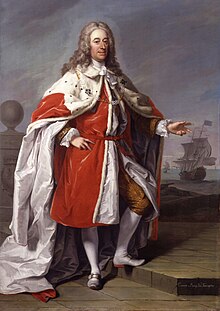The Viscount Torrington | |
|---|---|
 Admiral of the Fleet George Byng, 1st Viscount Torrington by Jeremiah Davison in 1733 | |
| Born | 27 January 1663[1] Wrotham, Kent |
| Died | 17 January 1733 (aged 69) Southill, Bedfordshire |
| Buried | Church of All Saints, Southill, Bedfordshire |
| Allegiance | |
| Service | |
| Years of service | 1678–1733 |
| Rank | Admiral of the Fleet |
| Commands | HMS Constant Warwick HMS Hope HMS Duchess HMS Royal Oak HMS Britannia HMS Nassau Mediterranean Fleet |
| Battles / wars | Glorious Revolution Nine Years' War |
| Awards | Knight Companion of the Order of the Bath |

Admiral of the Fleet George Byng, 1st Viscount Torrington, KB, PC (27 January 1663 – 17 January 1733), of Southill Park in Bedfordshire, was a Royal Navy officer and statesman. While still a lieutenant, he delivered a letter from various captains to Prince William of Orange, who had just landed at Torbay, assuring the Prince of the captains' support; the Prince gave Byng a response which ultimately led to the Royal Navy switching allegiance to the Prince and the Glorious Revolution of November 1688.
As a captain, Byng saw action at the Battle of Vigo Bay, when the French fleet were defeated, during the War of the Spanish Succession. As a flag officer, he led the bombardment squadron while serving under Admiral Sir George Rooke at the Capture of Gibraltar and then took part in the Battle of Málaga at a later stage in the same war.
Byng was sent to the Mediterranean to thwart any attempt by the Spanish to take Sicily. He encountered the Spanish fleet at Naples and, after pursuing it down the Strait of Messina, sent ahead his fastest ships causing the Spanish fleet to split in two. In the ensuing action, known as the Battle of Cape Passaro, the Spanish fleet was devastated: 10 ships of the line were captured, four ships of the line sunk or burnt and four frigates were captured at this early and critical stage of the War of the Quadruple Alliance. He went on to be First Lord of the Admiralty during the reign of King George II.
- ^ G. E. Cokayne; with Vicary Gibbs, H.A. Doubleday, Geoffrey H. White, Duncan Warr and Lord Howard de Walden, editors, The Complete Peerage of England, Scotland, Ireland, Great Britain and the United Kingdom, Extant, Extinct or Dormant, Gloucester, U.K.: Alan Sutton Publishing, 2000), volume XII/1, page 789